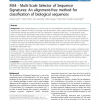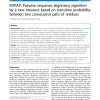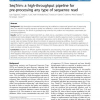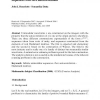133
click to vote
BMCBI
2010
15 years 1 months ago
2010
Background: While multiple alignment is the first step of usual classification schemes for biological sequences, alignment-free methods are being increasingly used as alternatives...
BMCBI
2007
15 years 1 months ago
2007
Background: The rapid burgeoning of available protein data makes the use of clustering within families of proteins increasingly important. The challenge is to identify subfamilies...
124
click to vote
BMCBI
2007
15 years 1 months ago
2007
Background: Detection of short, subtle conserved motif regions within a set of related DNA or amino acid sequences can lead to discoveries about important regulatory domains such ...
104
click to vote
BMCBI
2008
15 years 1 months ago
2008
Background: We propose a multiple sequence alignment (MSA) algorithm and compare the alignment-quality and execution-time of the proposed algorithm with that of existing algorithm...
BMCBI
2010
15 years 1 months ago
2010
Background: Sequence alignment is one of the most important techniques to analyze biological systems. It is also true that the alignment is not complete and we have to develop it ...
BMCBI
2010
15 years 1 months ago
2010
Background: High-throughput automated sequencing has enabled an exponential growth rate of sequencing data. This requires increasing sequence quality and reliability in order to a...
BMCBI
2010
15 years 1 months ago
2010
Background: Whole-genome sequence alignment is an essential process for extracting valuable information about the functions, evolution, and peculiarities of genomes under investig...
ADCM
2010
15 years 1 months ago
2010
Unimodular waveforms x are constructed on the integers with the property that the autocorrelation of x is one at the origin and zero elsewhere. There are three different constructi...
ICDE
2010
IEEE
15 years 1 months ago
2010
IEEE
Abstract— Nowadays, vast amount of routing data, like sequences of points of interests, landmarks, etc., are available due to the proliferation of geodata services. We refer to t...
AAAI
1997
15 years 2 months ago
1997
This paper describes an approach for representing and manipulating sequences in description logics (DLs). The key idea is to represent sequences using sux trees, then represent t...







